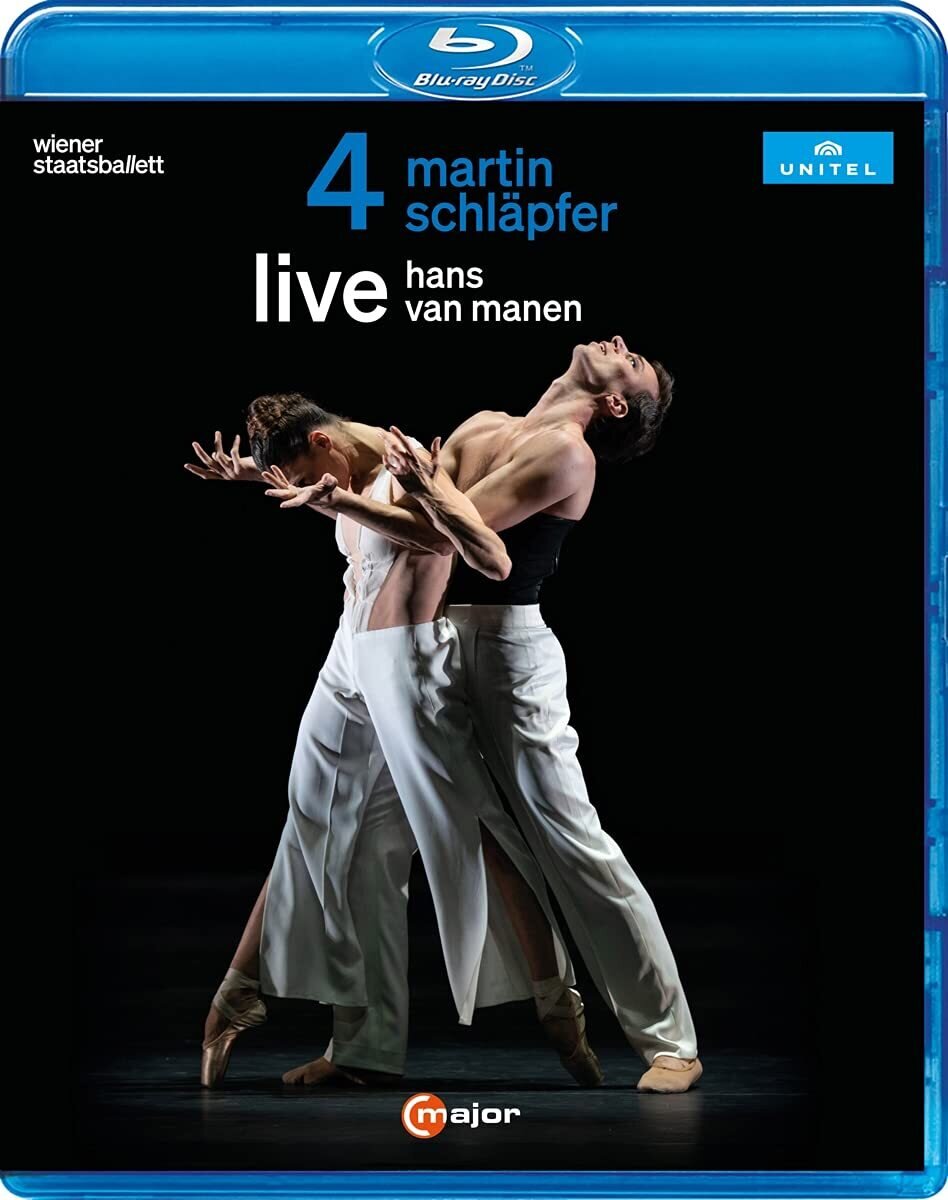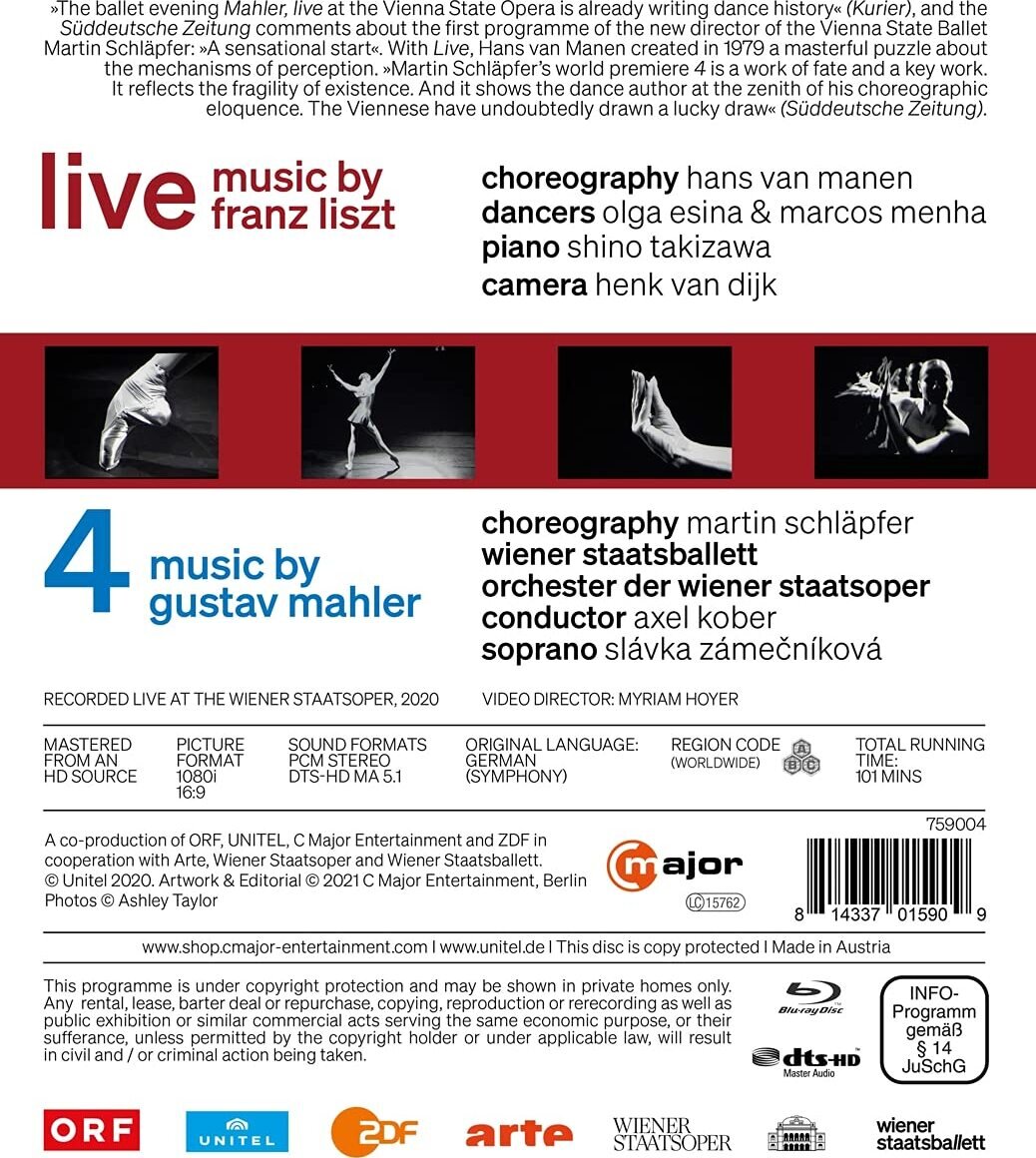

4 / Live double bill ballet show—something old, and then something new:
Live. Music by Liszt. Choreographed by Hans van Manen in 1979 for the Nederlands Dans Theater, where Live has been an iconic part its repertory. Subject title is the first production of Live outside the Netherlands. Staged after Hans van Manen by Rache Beaujean. Stars dancers Olga Esina and Marcos Menha. There is also a role for a cameraman. This role was created at the NDT by the then young “videomaster” Henk van Dijk. Now the 42-years-older Henk appears as guest artist in Vienna with his trusty camcorder wired to transmit signals to a movie projector. Pianist is Shino Takizawa. Costumes by Keso Dekker; lighting by Bert Dalhuysen. Live is a warm-up of about 23 minutes.
4 choreographed by Martin Schläpfer. Axel Kober conducts all of Mahler’s Symphony No. 4 with the Orchester der Wiener Staatsoper and soprano Slávka Zámečníková. Schläpfer became the new Director and Chief Choreographer for the Vienna State Ballet on September 1, 2020. He produced 4 about 3 months later with 89 dancers in the cast. Set design by Florian Etti; costumes by Catherine Voeffray; lighting by Thomas Diek.
Directed for TV by Myriam Hoyer. Shabby keepcase booklet in German with weak translation into English. There is no menu—you push PLAY and the whole show follows with Live first. The soprano sings in German and there are no subtitles in any language. The short titles of “4” and “Live” are hard to remember and index. At one point in the keepcase booklet and in other places the program is confusingly called Mahler, live! Sum up: this is the worst-crafted Blu-ray disc I’ve reviewed from a major publisher. However, SQ and PQ are OK. Released 2021, disc has 5.1 dts-HD Master Audio. Composite Grade: C+
Maybe the best thing about this title are 4 opening images below of architectural photography from Myriam, our new video heroine. These pictures of the Vienna Opera House are surrealistically beautiful. I’ve seen this building. It’s beautiful, but not as pretty as Hoyer has it. I think I know how she did this. First she worked with building management to get all those neat lights turned on. Then she contrived to keep anything moving out of the area. Finally, each of the four images is actually a single photograph made with still-photography high dynamic range (HDR). Each picture involves making up to 9 separate simultaneous images of the building at different exposure levels. The multiple images are then merged in a computer to form a single image with the best focused, best lit, and most colorful parts of the picture preserved in a whole. If the video is shot at 30 frames per second and an image below is to last 10 seconds, just repeat the single HDR image 300 times—the result is more glorious than what a tourist like me could ever see. Brava!
Live
Live has three characters: a female dancer, a male dancer, and a cameraman with what appears to be a vintage prosumer-level camcorder. The camcorder has one special feature: a radio that transmits video images to a projector that throws up grainy black-and-white camera images on a big screen. At the beginning of the piece, members of the audience (here spread out by Covid-19 social distancing) see the cameraman pointing his camera at them. Then they are startled to see themselves on the screen! The cameraman is dressed in black. But he is partially bald with gray hair. In most of our screenshots you can just barely see his face or head moving around in the darkness of the stage:
In the next shot below, the female dancer (Olga Esina) is facing the audience and the cameraman (Henk van Dijk) is about 8 feet away from her with his back to the audience. You can faintly see his bald spot and a tiny speck of light from the camera:
Next below, the cameraman is close behind the dancer. You can see a small image on the camera screen sticking out—this image is blown up on the big screen behind both the dancer and the cameraman:
It takes a while for us to figure out how the dancer and her images relate. Of course Myriam Hoyer has yet other cameramen at work recording all of this in full color:
When the cameraman is behind the dancer the images are backwards from what the audience sees:
As soon as you get this setup under control in your mind, a man (Marcos Menha) enters the stage and the woman sharply turns her head away:
And the strange goings-on on the stage are over as the woman flees the scene through a side door (followed by the cameraman):
The rest of this is shot, I assume, by Hoyer’s team with cameras set to black and white and equipped with radio gear. The man chases the woman and catches up with her in the lobby of the opera house. What we see in the home theater is excellent HD video. (I have no idea how the shots below may have looked to the folks in the audience.)
The dancer and the man are probably estranged ex-lovers, and the man has something else to say to the dancer:
This sets off quite a struggle until the man flees and the woman shuts down the camera:
Now the woman is grabbing her stuff and leaving the building. Below we see in a flashback her memory of breaking up with the man in a rehearsal room:
The woman is out of the opera house. She’s headed for a shelter to wait for the next trolley which runs along the Ringstrasse:
Hans van Manen is famous for fine art photography as well as his dance making. He was the first to incorporate real-time electronic images into a dance piece. In 1979, Live was ground breaking. Today, camcorders are museum pieces. Half the population can use their telephones to make videos like this in full color and high-definition. And this black-and-white show is intended to be nostalgic (especially compared to the hyper-aggressive improvisations and semi-nude dancing you see now at houses like the NDT).
Below are the dancer, the man, and cameraman taking bows. They know how to milk even the smallest crowd; the bashful pianist hasn’t any idea what to do:
4
The music to 4 is a complete rendition of Mahler’s Symphony No. 4. Big music calls for a big show. This gives Schläpfer a chance to keep his dancers happy with stage time. Behold below Myriam Hoyer’s fine shot of what may be the biggest and best ballet orchestra in the world:
The set consists of one triangle on the back wall that changes its look from time to time, no props, and some faint lights emerging from the flanks at floor level. This worked fairly well with large masses of dancers:
Symphony Number 4 is Maher’s happiest major work. But Schläpfer is so serious!
Mixed nudes walking away provide a couple of seconds of relief from the somber proceedings:
Hoyer gets some good close-ups:
And here’s a faint smile:
Here are 2 bottoms shots that don’t add much to the show:
Next below are six images showing how bad the lighting was on this stage with smaller formations:
Execution of the steps was generally weak, no doubt due to too little rehearsal time. This becomes especially obvious in smaller groups:
The company has been through traumatic changes in recent months as director Legris was replaced by Schläpfer and there was wholesale turnover of dancers. At the conclusion, all hands are on deck to show a symbol of unity with their arms:
Or are they all just ashamed (including the soprano)?
Print critics who saw this streamed were lukewarm. This is probably the weakest performance by a major ballet company to be published in Blu-ray. It deserves a D grade (buy only if you have a special reason). But I’m sure Schläpfer did his best to follow the law that the show must go on. And Schläpfer got lucky when Myriam Hoyer came on board. I ran the numbers on her video of 4 with a Wonk Ballet Worksheet. She kept it simple and used a small number of cameras to shoot head on—maybe the absence of a big audience helped her. She was especially generous in making long segments of small groups of dancers. Her overall score on video pace was 14 seconds per clip, and 75% of her shots show the whole bodies of dancers. Wow! This score overlaps (just barely) with the uniquely great ballet videos of Vince Bataillon!
Composite Grade
I’ll give Live a B+ as an historical curiosity piece. 4 starts off with a D. The miserable keepcase booklet and disc authorship knocks the grade down to D-. But Hoyer’s fine video file brings this up to C-. Now I blend the short B+ and Hoyer’s pictures of the Opera house with the long C- to come up with C+ for the composite grade of the title. It pains me to give such a poor grade to the Vienna State Opera Ballet, but it’s the best I can do.
Here’s an official trailer from C Major. Alert! The video shown here is not from Myriam Hoyer’s video file. Hoyer’s work is better than what you see here:
OR











































